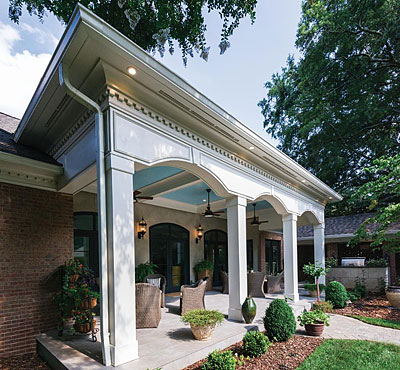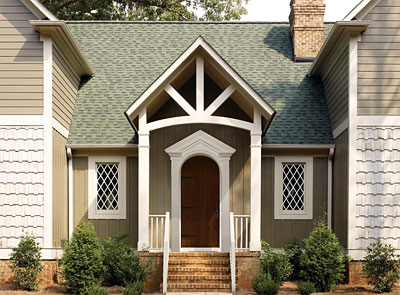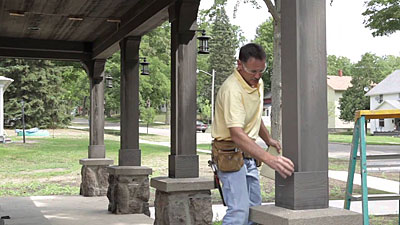Adding the Right Columns for Your Home
by Rachel Lyon, Editorial Director for Direct from the Designers™
Architectural elements make a home stand out, whether they are purely structural or decorative in nature. From the façade through the interior, finer touches that complement a house’s style are a sure way to amp up its appeal and increase property value. The column is still one of the most common elements in use, so here’s how to use columns to your design advantage!
Choosing the Best Shape
Columns were born in the Mediterranean area, where they were used to support grand stone structures, some of which are still standing today after thousands of years. While most of these are cylindrical in shape, it is very common to see rectangular columns on houses these days. Large Neoclassical and Tuscan designs are most likely to stick to the original aesthetic.
Wood was more readily available in other hotbeds of architecture, and because it’s easier to carve into shapes with angles, the rectangular column came into existence. Taking from the past, straight up and down types became very popular for many house styles, including simple ranches, farm houses, and traditional as well as most modern plans. Tapered rectangular columns became the hallmark of the Arts and Crafts movement, and they are found on Craftsman, bungalow, and some cottage homes nowadays. When in doubt about which shape to choose, consider if your house has a decorative style that is neat and simple or ornate, and where that style is based in history.
Balance the Space
Once you decide on the basic type of column you want to use, you need to consider the amount of space you have to work with and the level of decoration in the surrounding area. Balancing both of these aspects will create a beautiful finished look.
In general, wider entries, porches, gallery hallways, etc., can support thicker columns, but there is a point where smaller isn’t necessarily better for narrow spaces. If they are too thin, your home will seem out of proportion and skimpy. This issue is usually only encountered with non-tapered columns, and it helps to match their width to other decorative elements for a cohesive final picture. Be sure to ask a professional for recommendations if you’re unsure about what size to install—they have seen it before and can help you select columns that complement the rest of your home’s structure.
Columns range from very plain to ornate with intricate detailing, and the best style also takes the rest of the house into consideration. Very large and round columns usually make enough of a statement without extra decoration, but as they size down to those that suit the average house, you can consider things like recessed and raised panels for tapered and non-tapered styles, and fluting for the latter only. Homes with Craftsman influence are fairly easy, because you can’t go wrong with a little extra flair, but the basic tapered shape gets noticed, too. Traditional homes with non-tapered columns tend to look their best when paired with different levels of adornment; that is, a more complicated farm house works well with plain columns, while a very plain, blocky colonial house can be upgraded with some fluting to draw the eye. Search online to see what other homes of the same style use for inspiration!
Posts vs. Columns
The difference between posts and columns can be blurred, but in the simplest terms, posts tend to be narrower and are more likely to have the appearance of wood than stone. Whether they look like solid beams or are delicately carved, posts also have their place in architectural design, and they help fill niches where columns don’t fit the style of the house or are just plain overpowering. Very old and rustic homes are complemented well by simple posts stained to match the exterior, while Victorian designs call for intricate porch posts that match their balusters. Traditional columns would be very awkward in these cases, but the right posts extend the personality of the home in just the right way.
If you’re looking to complete your house with columns or posts, take a look at Fypon’s® extensive catalog of lightweight, highly durable, moisture- and insect-resistant PVC and polyurethane products. Their column wraps allow you to dress up a support to look its best, and if you want professional recommendations, their Takeoff Service can suggest the best architecturally accurate pieces for your home. It couldn’t be easier to upgrade your home’s style!
BROWSE HOME PRODUCT ARTICLES
- Creating a Spa-Like Master Bathroom »
- Designing a Water-Efficient Bathroom »
- Design a Modern Bathroom »
- View All Bathroom Articles »
- Building a New Home »
- Building a Duplex »
- Finding the Right Home Builder »
- View All Building Tips Articles »
- Adding the Right Columns»
- Decorative Touches for Your Interior»
- Shutters for Every Architectural Style »
- View All Columns & Millwork Articles »
- How to Use Specialty Laminates »
- Decorative Touches for Your Home's Interior
- View All Countertops and Surfaces Articles »
- What Goes Into a Great Deck? »
- Decorative Touches for Your Home's Interior »
- View All Decking Articles »
- Choosing Glass for Your Entry »
- Stylish Personas for Your Front Door »
- Using Sidelites and Transoms »
- View All Door Articles »
- Choose Siding for Your Region »
- Get the Most Out of Exterior Paint »
- Mixing Siding to Define Your Exterior »
- View All Exterior Articles »
- Finding the Right Home Builder »
- The Appeal of Small House Plans »
- Choosing the Perfect Floor Plan »
- View All Finding a Home Plan Articles »
- Colorful Flooring for Your Home »
- Designing With Different Widths»
- Chic, Neutral, Gray Flooring »
- View All Flooring Articles »
- Garage Doors That Add Curb Appeal »
- Caring for Your Garage Doors »
- Benefits of Insulated Garage Doors »
- View All Garage Door Articles »
- Reclaimed Products for Your Home »
- Building a Green and Stylish Home »
- Benefits of Building with SIPS »
- View All Green Building Articles »
- Cool Gadgets for Your New Home »
- Creating a Hi-Tech Home »
- Efficient Gifts for New Homeowners »
- View All Home Electronics Articles »
- Improve Your Home's Air Circulation »
- How to Improve the Air Circulation in Your Home »
- View All HVAC Articles »
- Bedrooms Designed for Sleep »
- Selecting a Fireplace for Your Home »
- Crafting a Luxurious Master Suite »
- View All Interior Design Articles »
- Design the Perfect Outdoor Space »
- Dive into a Beautiful Pool »
- Design a Sizzling Outdoor Kitchen »
- View All Outdoor Living Articles »
- Apps to Help You Pick Paint Colors »
- Create the Perfect Mood with Paint »
- How to Read the Color Wheel »
- View All Painting & Decorating Articles»
- Creating a Spa-Like Master Bathroom »
- High-Impact Kitchen Upgrades »
- Creating a Water Efficient Bathroom »
- View All Plumbing Fixtures Articles»
- Cladding That Complements Your Exterior »
- Reasons to Consider Prefinished Siding »
- View All Siding & Cladding Articles»
- All About Solar Powered Skylights »
- Natural Lighting for the Dark Corners of Your Home »
- Design a Better Bedroom with Skylights »
- View All Skylight Articles»




